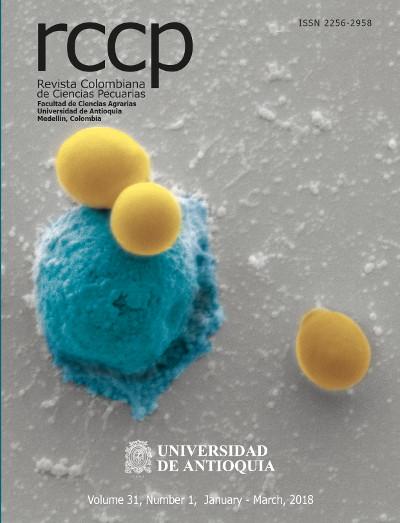Cross sectional study of 13 leptospira serovars in a Colombian dairy region
DOI:
https://doi.org/10.17533/udea.rccp.v31n1a02Keywords:
dairy cattle, leptospirosis, MAT, prevalenceAbstract
Background: Leptospirosis in cattle is recognized as a major cause of reproductive loses due to abortions, early embryonic death, and infertility. The type of Leptospira serovars that are currently circulating in Colombian herds is largely unknown due to the lack of national reports. Objective: The prevalence of antibodies specific to 13 Leptospira spp serovars was investigated in unvaccinated cows from 26 herds in San Pedro de los Milagros (Province of Antioquia) dairy region. Methods: Microscopic agglutination test was used on serum samples, following WHO recommendations. Results: A total of 112/900 (12.4%) of the animals had antibody titers of 1:100 or greater to at least one Leptospira serovar. Of those positive, 34/900 (3,8%) animals seroconverted to two or more serovars. In order of decreasing prevalence, the serovars detected were: hardjo prajitno, pomona, grippotyphosa, tarassovi, copenhageni, canicola, cellodeni and bratislava. There were 28 animals seropositive to serovar hardjo. Conclusion: Our results indicate that leptospirosis should be included as a differential diagnosis for various reproductive problems in this region.
Downloads
References
Garoussi TM. The prevalence of heifer mastitis due to Leptospirosis. Heifer mastitis conference. Ghent-Belgium. June 2007, 24- 26. pp 148-149.
Gerritsen MJ, Koopmans MJ, Olyhoek T. Effect of streptomycin treatment on the shedding of and the serologic responses to Leptospirainterrogans serovar hardjo subtype hardjobovis in experimentally infected cows. Vet Microbiol 1993; 38:129-135.
Grooms DL, Bolin CA. Diagnosis of fetal loss caused by bovine viral diarrhea virus and Leptospira spp. Vet Clin North Am Food Anim Pract 2005; 21: 463-472.
Lilenbaum W, Martins G. Leptospirosis in cattle: A challenging scenerio for the understanding of the epidemiology. Transbound Emerg Dis 2014; 61(Sup):63-68.
Office International des Epizooties (OIE). Leptospirosis. 2014. Chapter 2.1.9.
Peregrine AS, Martin SW, Hopwood DA, Diffield TF, McEwen B, Hobson JC and Hietala SK. Neosporacaninum and Leptospiraserovar serostatus in dairy cattle in Ontario. Can Vet J 2006; 47:467-470.
Pinto PS, Loureiro AP, Penna B, Lilenbaum W. Usage of Leptospira spp, local strains as antigens increases the sensitivity of the serodiagnosis of bovine leptospirosis. Acta Trop 2015; 149:163-167.
Prescott JF, Miller RB, Nicholson VM, Martin SW, Lesnick T. Seroprevalence and association with abortion of leptospirosis in cattle in Ontario. Can J Vet Res 1988; 52:210-215.
Radostitis MO, Gay CC, Hinchcliff KW, Constable P.Veterinary medicine. 8th ed. Philadelphia, USA: Saunders Elsevier 2007.
Rajeev S, Berghaus RD, Overton MW, Pence ME, Balwin CA. Comparison of fluorescent antibody and microscopic agglutination testing for Leptospira in pregnant and nonpregnant cows. J Vet Diagn Invest 2010; 22:51-54.
Ramírez NF, Villar Argaiz D, Fernández Silva JA, Londoño Pino J, Chaparro Gutiérrez JJ, Olivera Angel ME. Seroprevalence and risk factors for several viral diseases in bovines from dairy herds in San Pedro de los Milagros Antioquia, Colombia. Rev CES Med Zootec. 2016; 11(1):15-25.
Van de Weyer LM, Hendrick S, Rosengren L, Waldner CL. Leptospirosis in beef herds from western Canada: Serum antibody titers and vaccination practices. Can Vet J 2011; 52:619-626.
Downloads
Published
How to Cite
Issue
Section
License
Copyright (c) 2017 Revista Colombiana de Ciencias Pecuarias

This work is licensed under a Creative Commons Attribution-NonCommercial-ShareAlike 4.0 International License.
The authors enable RCCP to reprint the material published in it.
The journal allows the author(s) to hold the copyright without restrictions, and will allow the author(s) to retain publishing rights without restrictions.






